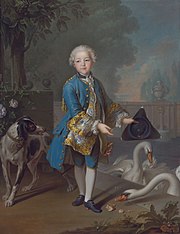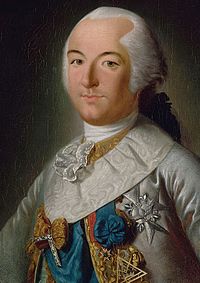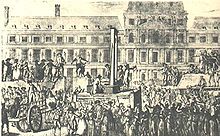Louis Philippe II, Duke of Orléans
| Louis Philippe II Philippe Égalité | |
|---|---|
First Prince of the Blood Duke of Orléans | |
 Portrait by Antoine-François Callet | |
| Born | Louis Philippe Joseph d'Orléans 13 April 1747 Château de Saint-Cloud, Saint-Cloud, Kingdom of France |
| Died | 6 November 1793 (aged 46) Paris, French First Republic |
| Spouse |
Louise Marie Adélaïde de Bourbon (m. 1769) |
| Issue |
|
| House | Orléans |
| Father | Louis Philippe I, Duke of Orléans |
| Mother | Louise Henriette de Bourbon |
| Signature | |
Louis Philippe II, Duke of Orléans (Louis Philippe Joseph; 13 April 1747 – 6 November 1793), was a French
Louis Philippe II was born at the
In 1792, during the
Early life

Louis Philippe Joseph d'Orléans was the son of
Philippe was born at the Château de Saint-Cloud, one of the residences of the Duke of Orléans, five kilometers west of Paris. His older sister, born in 1745, died when she was six months old. His younger sister, Bathilde d'Orléans, was born in 1750.
Succession
Philippe's first title, given to him at birth, was that of the
Personal life
Marriage
On 6 June 1769, Louis Philippe married
Scandals

During the first few months of their marriage, the couple appeared devoted to each other, but the Duke went back to the life of libertinage he had led before his marriage. The Duke was a well-known womanizer and, like several of his ancestors, such as Louis XIV and Philippe II, Duke of Orléans, had several illegitimate children.
During the summer of 1772, the Duke began his secret liaison with one of his wife's ladies-in-waiting,
It was alleged that Lady Edward FitzGerald, born Stephanie Caroline Anne Syms, also known as Pamela, was a natural daughter of the Duke and the Countess of Genlis. He recognized a son he had with Marguerite Françoise Bouvier de la Mothe de Cépoy, comtesse de Buffon, Victor Leclerc de Buffon (6 September 1792 – 20 April 1812), known as the chevalier de Saint-Paul and chevalier d'Orléans.[4]
Military career
In 18th-century France, it was very common for royal princes to receive high positions in the military. From a young age, Philippe d'Orléans displayed his interest in naval matters, and he received three years of training in the navy.
In 1776, he held the rank of
When the
Orléans returned to Paris claiming the battle had been a resounding victory, and received a hero's welcome. When it transpired that these claims were overstated, that the battle had been more of a draw, Orléans' credibility suffered an unrecoverable blow. He withdrew from the navy and asked the army if they could give him a position, but it was denied.[10]
Role in the French Revolution

Liberal ideology
In August 1787 the Duke of Orléans and his secretary Charles-Louis Ducrest, the brother of Madame de Genlis, came up with proposals to improve the financial situation of France.
In addition to being a Jacobin, Philippe was also the
Philippe was also a strong admirer of the British constitutional monarchy.[4] He strongly advocated for France's adoption of a constitutional monarchy rather than the absolute monarchy that was present in France at the time.[15]
Palais-Royal
As the new Duke of Orléans, one of the many estates Philippe inherited from his father was the Palais-Royal, which became known as the Palais-Égalité in 1792,[16] because he opened up its doors to all people of France, regardless of their estate (class). He employed Swiss guards to refuse entry only to "drunkards, women in excessively indecent dress, and those in tatters."[17] He built shops and cafés where people could interact, and soon it became a hub for social life in Paris. As the Parisian police had no authority to enter the Duke's private property, it became a hub for illegal activity, such as trade in stolen goods, suspicious deals, and the spread of revolutionary ideas. In fact, it was a common place for Jacobins to meet and discuss their plans and ideas.[13] Many members of the National Assembly claimed that the Palais-Royal was the "birthplace of the Revolution." Philippe's goal was to create a place where people could meet, which he argued was a crucial part of democracy and a "physical need for civil life."[17]
During the months leading up to the outbreak of revolutionary violence in July 1789, Philippe d'Orléans undertook several personal actions having the effect of increasing his personal standing amongst the population at large. These included his endorsement of a pamphlet outlining the process to be followed in the setting up of local assemblies,
Leadership in the Estates-General
Philippe d'Orléans was elected to the
Women's March on Versailles and exile
One of the main accusations thrown at Philippe d'Orléans was the initiation of the Women's March on Versailles on 5 October 1789, which people believed was done in order to overthrow the King and gain popularity amongst the people. He was accused of funding the riots, as well as calling the rioters his "friends", who were chanting: "Vive Orléans" or "Long live our father, long live King d'Orléans!" The High Court of the Grand Châtelet also accused him of acting as an accomplice to Honoré Gabriel Riqueti, comte de Mirabeau, in an attempt to murder Louis XVI and his wife, Marie Antoinette, during this period. Early in the morning on 6 October a group of protesters entered the palace through an unguarded gate, searching for the queen's bedchamber, they were quickly followed by many and fighting with royal guards flared in the halls and outside the queen's apartments. Marie Antoinette and her ladies barely escaped to the king's bedchamber in front of the violent intruders; the queen was suspicious that d'Orléans had arranged the attempted attack on her. Marie Antoinette's daughter Marie-Thérèse shared the same suspicion later writing that, "[t]he principal project was to assassinate my mother"[22]
The Marquis de Lafayette, who was very influential in France at the time and a supposed "friend" of d'Orléans, suggested to him to go to the British Isles with the promise that he could potentially become the head of state of Brabant. However, it is likely that Lafayette viewed d'Orléans as a threat to his control of the revolutionary politics and that he intended to get Philippe out of the country.
At first, it was difficult to convince d'Orléans to leave France during these troubling times, but after strong pressure and enticement from Lafayette, he ended up leaving. Throughout his weeks in exile, he wrote several letters expressing his strong desire to return to France. After spending months in the British Isles d'Orléans returned to France for the Fête de la Fédération; but he never regained the same influence that he enjoyed in 1789 prior to his departure. Those who did not support him, as well as people overseas, labeled him as a coward for fleeing to England as a result of accusations against him, calling it a period of "exile." However, he was able to keep his position in the National Assembly until it disbanded on 30 September 1791.[4]
Citoyen Égalité
Due to the liberal ideology that separated Philippe d'Orléans from the rest of his royal family, he always felt uncomfortable with his name.[
Égalité also attributed his new surname to the reputation of generosity that he had among the people of France, especially the poor. He was well known for distributing food and money to the poor, as well as providing shelter for homeless during the severe winter of 1788–1789.[17]
Relationship with King Louis XVI
Although a relative of King Louis XVI, Philippe d'Orléans never maintained a positive relationship with his cousin. Upon inheriting the title of Duke of Orléans, Philippe also became the Premier Prince du sang – the most important personage of the kingdom after the king's immediate family. Therefore, he would be next in line to the throne should the main Bourbon line die out.[26] For this reason, many [who?] supposed that Philippe's goal was to take his cousin's throne. Philippe and the King's wife, Marie Antoinette, also detested each other. Marie Antoinette hated him for what she viewed as treachery, hypocrisy and selfishness, and he, in turn, scorned her for her frivolous and spendthrift lifestyle.[27] The King's reluctance to grant Philippe a position in the army after the indecisive result at the Battle of Ushant is said to be another reason for Philippe's discontent with the King.[10]
One of the most astounding events occurred when Philippe took a vote in favor of Louis XVI's execution. He had agreed among close friends that he would vote against his execution, but surrounded by the Montagnards, a radical faction in the National Convention, he turned on his word, to the surprise of many.[10] A majority (75 votes) was necessary to indict the King, and an overwhelming number of 394 votes were collected in favor of his death. The King was especially shocked by the news, stating:
"It really pains me to see that Monsieur d'Orléans, my kinsman, voted for my death."[13]
Death

On 1 April 1793, a decree was voted for within the National Convention, including Égalité's vote, that condemned anyone with "strong presumptions of complicity with the enemies of Liberty." At the time, Égalité's son, Louis Philippe, who was a general in the French Revolutionary Army, joined General Charles François Dumouriez in a plot to visit the Austrians, who were an enemy of France. Although there was no evidence that convicted Égalité himself of treason, the simple relationship that his son had with Dumouriez, a traitor in the eyes of the Convention, was enough to get him and Louis Charles, Count of Beaujolais arrested on 4 April 1793, and the other members of the Bourbon family still in France on the days after. He spent several months incarcerated at Fort Saint-Jean in Marseille until he was sent back to Paris. On 2 November 1793, he was imprisoned at the Conciergerie. Tried by the Revolutionary Tribunal on 6 November, he was sentenced to death,[13] and guillotined the same day.[28]
Issue
The Duke and Duchess of Orléans had six legally-recognized children:
- A daughter (died at birth, 10 October 1771);
- Louis Philippe I, King of the French (6 October 1773 – 26 August 1850), King of the French (1830–1848);
- Louis Antoine Philippe d'Orléans (3 July 1775 – 18 May 1807), died in exile in Salt Hill, then in Buckinghamshire, England;
- Françoise d'Orléans Mademoiselle d'Orléans (twin sister of Adélaïde) (1777–1782);
- Louise Marie Adélaïde Eugénie d'Orléans; (23 August 1777 – 31 December 1847);
- Louis Charles d'Orléans (17 October 1779 – 30 May 1808), died in exile in Malta.
Ancestry
| Ancestors of Louis Philippe II, Duke of Orléans Louise Françoise de Bourbon | |||||||||||||
|---|---|---|---|---|---|---|---|---|---|---|---|---|---|
Sources and references
Notes
Citations
- ^ "Louis Philippe Joseph Orléans, Duc d'." Columbia Electronic Encyclopedia, 6Th Edition, Apr. 2016, p. 1.
- ^ Chisholm, Hugh, ed. (1911). "Orleans, Louis Philippe Joseph, Duke of".Encyclopædia Britannica. 20 (11th ed.). Cambridge University Press. pp. 284–285.
- ISBN 9780385489492.
- ^ a b c d e Elder, Richard W. The Duc d'Orleans, Patriot Prince Or Revolutionary? an Investigation into the Chatelet Inquiry of 1789-1790, Central Michigan University, Ann Arbor, 1994.
- ISBN 9782262010720.
- ^ Lacour-Gayet (1905), pp. 80–81.
- ^ Troude (1867), p. 7.
- ^ Lacour-Gayet (1905), pp. 615–617.
- ^ Chack (2001), p. 379.
- ^ a b c Harris, Robert D. "Philippe Égalité." American Historical Review, vol. 103, no. 4, Oct. 1998, p. 1258.
- ^ "Charles-Louis Ducrest (1747-1824)".
- JSTOR 286283
- ^ a b c d e Wernick, R. "Radical and Chic, a Duke Who Courted Revolt and Doom." Smithsonian, vol. 20, no. 4, July 1989, p. 66.
- ^ MACKEY MD, Albert C, "Letter O; Orléans, Duke of", Encyclopedia of Freemasonry and its Kindred Sciences
- ^ Kelly, George (December 1979). "The Machine of the Duc D'Orléans and the New Politics". The Journal of Modern History. 51 (4): 669.
- ISBN 9780140443523.
- ^ a b c McMahon, Darrin M. "THE BIRTHPLACE OF THE REVOLUTION: PUBLIC SPACE AND POLITICAL COMMUNITY IN THE PALAIS-ROYAL OF LOUIS-PHILIPPE-JOSEPH D'ORLÉANS, 1781–1789." French History 10.1 (1996): 1-29.
- ISBN 0-670-81012-6.
- ISBN 0-670-81012-6.
- ISBN 0-670-81012-6.
- ^ Gottschalk, Louis R. The Era of the French Revolution 1715–1815). Boston: Houghton Mifflin, 1957.
- ^ Fraser, Antonia. Marie Antoinette: The Journey. Doubleday, 2001, p.295
- ^ Desodoards, A. F., Histoire philosophique de la Révolution de France, Tome II, 6th Edition, Paris, 1817, pp. 176–177
- ISBN 1138755087.
- ISBN 978-3734074752.
- ^ Velde, François. "The French Royal Family: Titles and Customs". www.heraldica.org. Retrieved 2017-02-27.
- ^ Albert Soboul, Dictionnaire Historique de la Rév. Fr. Paris 1989 (PUF) S. 800
- ^ Lewis, Gwynne. "Why Philippe Égalité Died on the Scaffold." TLS, no. 4900, 28 Feb. 1997, p. 30.
- ^ Genealogie ascendante jusqu'au quatrieme degre inclusivement de tous les Rois et Princes de maisons souveraines de l'Europe actuellement vivans [Genealogy up to the fourth degree inclusive of all the Kings and Princes of sovereign houses of Europe currently living] (in French). Bourdeaux: Frederic Guillaume Birnstiel. 1768. p. 90.
References



